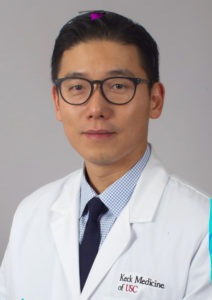
Among the highlights from the “‘Endovation’—Endovascular Innovation for Urgent and Emergency Complex Aortic Disorders” session coming up at the 2022 Vascular Annual Meeting (VAM) Wednesday, June 15, is a presentation by Sukgu M. Han, MD, from the Keck Medical Center at University of Southern California, Los Angeles—“Guidelines from the front lines: Can we develop best practices or standardization for endovascular alternative techniques, and when should we use alternative techniques?”
“I will be reviewing our own aortic center experience at the Keck Medical Center of University of Southern California, serving as a regional aortic center accepting more than 250 urgent aortic transfers annually,” Han tells Vascular Specialist, offering VAM 2022 attendees a glimpse of what they can expect.
“Among the acute aortic pathologies, I will focus on urgent and emergent thoracoabdominal, suprarenal aortic aneurysms (TAAA/SRAAA),” he notes, adding that the presentation will include a brief overview of results from the Keck Medical Center, as well as those reported in literature on various off-label complex endovascular aneurysm repair (EVAR) techniques, which he details will include parallel grafting, in-situ fenestration, and physician-modified endografting.
Han continues: “Our own institutional algorithm for treatment of TAAA/SRAAA will be shared, while highlighting the fact that each individual algorithm may differ depending on access to technology, technical expertise, regulatory, and reimbursement challenges.” Finally, says Han, standardization in technique and clinical indication for these techniques is possible only when “we have robust data, which is currently lacking.” His presentation will end by summarizing some of the work currently ongoing for a multicenter, international PMEG registry.
Elsewhere, the Endovation will feature a range of non-traditional surgical solutions in emergency situations during the non-traditional Endovation session at VAM (3–4:30 p.m. Wednesday, Room 210). Beyond lecture presentations, vascular trainees will discuss cases they submitted that used innovative surgical solutions, solving an aortic problem with endovascular means.
The case discussion portion is called “Cases Under the Stars” and will occur in a reception-like setting and atmosphere with drinks included. Trainees have submitted case studies for possible use in the session.
“This educational session aims to highlight options for treatment of complex aortic disorders using existing approved devices in innovative and creative ways,” said Jonathan Bath, MD, who is helping plan the Endovation line-up.
“We hope that this session will provide an overview of current solutions in contemporary practice to bridge the gap for patients with a need for complex aortic treatment.”
The focus will be on solutions that can be applied in urgent or emergency situations, he said, encompassing:
- Device modification (e.g., chimney, laser, back-table fenestration)
- A device used in a non-traditional manner, such as OCTO fen, an innovative solution utilizing standard infrarenal devices associated with fenestrated graft to repair a thoracoabdominal aneurysm
- Hybrid operations, such as a combination of an endovascular device with surgery, e.g., a bypass sewn to modified aortic device
“Clearly for some patients in this era, an open operation may be neither tolerated nor warranted due to surgical risk,” said Bath. “Although there are an array of complex devices in clinical trials or within the auspices of an investigational device exemption, there are a limited number of physicians who have been granted access to these devices.”
Most physicians who may encounter complex endovascular problems cannot rely upon these avenues, he said. In addition, patients in emergency or urgent situations may not be able to wait, or for whom access to a facility with such devices is simply not feasible.
Grayson Pitcher, MD, and Sherene Shalhub, MD, will co-moderate this concurrent session. In addition to the case studies, presentations cover a broad array of complex aortic interventions.
- “Chimney, snorkel and other parallel graft techniques—patient selection, configuration and access are key to durability,” Ross Milner, MD
- “In-situ laser fenestrated techniques for the visceral segment: Strategies for visceral perfusion, target cannulation and lessons learned,” Jonathan Bath, MD
- “In-situ fenestrated techniques for the aortic arch: How to minimize cerebrovascular complications and ensure adequate seal,” Mathew D. Wooster, MD
- “Navigating regulatory and reimbursement pathways: Experiences from the PMEG and IDE landscape,” Sara L. Zettervall, MD
- “Failure modes of endovascular therapy for complex aortic disorders: When is enough enough,” Eanas S. Yassa, MD
The Endovation session takes place from 3–4:30 p.m. in Hynes Convention Center Room 210.












